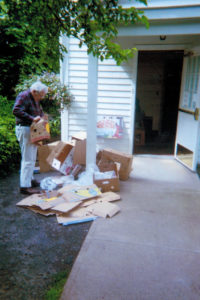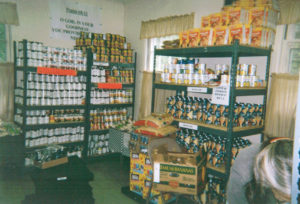Exploring the Spirituality of Hunger in America – New Beginnings Part 1

Part 1
I began this memoir before I even knew it. On the first day I worked in the basement food pantry, I sat with Mary, a member of St. Gregory’s Episcopal Church and the head of the alter society. We greeted a couple dozen hungry people. Mostly single homeless men, there were a few of Woodstock’s famous colorful characters included in the mix that day.
Throughout my career in the pantry, the most colorful of the colorful was Grandpa Woodstock who liked to bring his bride, Lady Estar into the pantry to shop. The two of them went around the room choosing from peanut butter, cereal, tuna fish, and soup. While this happened, he entertained us gushing enthusiastically.
“My, how beautiful you look today!” I fell for his spiel every pantry day. Those words melted my heart. The most professional of the street actors, he knew how to make us each feel special when he flashed his peace sign and posed for photographs. Grandpa knew how to flash that peace sign, whip out his postcards to sell, and sound off his horn “toot toot”. I sometimes thought he spent a few afternoons posing in front of a mirror to figure out how to get the best response from tourists.
Grandpa Woodstock and Lady Estar were most photogenic with their long, flowing silver hair. Their lovely matching beards only emphasized floral print silk skirts and kimonos. Their toenails were painted matching colors and their Teva sandals matched.
None of Woodstock’s rich and famous got so many requests for autographs and photographs. They simply couldn’t compete with his show off tricks.
After all, Grandpa entertained us all with street theater at its finest. So what if he didn’t mean a word of it? We all enjoyed being sucked into the show!

 Thank you for reading this article. Please refer it to your preferred social media network.
Thank you for reading this article. Please refer it to your preferred social media network.
Thurman Greco

LOCATION, LOCATION, LOCATION
He was simply one man working for others. He was paid a wage that could barely keep him alive. And he was one injury away from being homeless.” – David Baldacci
On two successive years I formed building committees composed of community leaders. Neither group came up with a workable plan. These committee members knew Woodstock inside and out: the buildings, the land, the zoning limitations. They really didn’t see much hope. The person who came closest to getting us a building was Bob Baker. If he hadn’t gone to Trinidad for the winter that year, I think we would have gotten a building.
As the hallways became more crowded and the lines became longer, the situation in the pantry became more and more difficult for everyone.
Turning the people away was just not a viable option for me. I knew the people had no where else to shop.
So, I began to look for another place. In reality, there was just not another place out there. We couldn’t leave Woodstock because we had shoppers who couldn’t, for whatever reason, go to another town.
As Andrea put it “Thurman, is there a sidewalk from the Woodstock Reformed Church to West Hurley?”(Or wherever the newly found choice might be.)
Besides, the money needed to get a building was, to my way of thinking, unreal. Putting myself in the head of a Woodstock property owner, I saw exactly what was happening. Here was a small town with a problem no one was willing to do anything about. Obviously, a new location was going to happen sometime. If the landlords and building owners could just hold on and “wait us out”, one of them was going to win the lottery and the townspeople were going to pay the bill.
There were several empty buildings in Woodstock.
Peggy Johnson seriously wanted us to have a building.
So, one day, Peggy went into gear. She started looking. She identified the Bearsville Garage, the old Odd Fellows Hall, the Overlook Press Building. Whenever she found something she thought would work, she would call together Rich Allen, Richard Spool, Guy Oddo, and anyone else who would pay any attention to her, and get them to look at it.
The Bearsville Garage was, to my mind, perfect. It had no neighbors close by. People were accustomed to seeing cars parked at this location. the price was lower than that of other buildings. The building was a totally utilitarian structure. However, it wasn’t 100% accepted. There were concerns about the toxins in the buildling left over from the garage business. The fact that other pantries in New York State operated out of old gas stations didn’t seem to compute with this committee.
The Overlook Press building was across the street from the Bearsville Garage. It had a large two-story “home” in the front of the property with space in the rear for parking a truck. There was space for food storage, office space, parking space, pantry. With all of this, there was also an opportunity for rental income from the apartment on the grounds.
And, finally, the Odd Fellows Hall was also available. We were contacted by an organizational representative one day, without warning. Did we want the building? Would we buy the building NOW? Our committee went over to see it, inspect it, and discuss it. We were interested. Richard Spool went over it with a fine tooth comb and pronounced it in good shape.
Our whole process took about three weeks. For a small, nonprofit organization, that was moving at the speed of light.
By the time we were ready to begin to figure out how to get the money together, they had already sold it.
Although I said nothing at the time, I felt their offer was not serious.
And, looming over all of this time period was the realization that these buildings were running in the hundreds of thousands and we had $12,000 in our coffers.
As badly as we needed a bigger space, we simply didn’t have the money.
Thank you for reading this blog/book.
Please refer this article to your preferred social network.
Please post a comment.
Peace and food for all.
Thurman Greco





